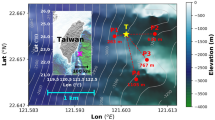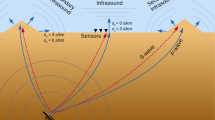Abstract
SENSITIVE microbarographs which respond to atmospheric pressure variations of a few tens of μbar at periods ranging from 30 s to 5 min can detect the pressure waves set up by atmospheric explosions1. Wind eddies and internal gravity waves of meteorological origin produce more or less similar disturbances, however. The basic problem is to distinguish the signal on the basis of its dispersive pattern, vector velocity and frequency structure against this background. Array techniques have been used successfully in seismology2, oceanography3, magnetism (R. L. Komack, unpublished) and acoustics4,5 to detect wave disturbances and trace their origin. The first step in determining the apparent horizontal velocity of the acoustic gravity wave is to calculate the cross-correlation function for each pair of sensors of an array  which is a measure of coherence between the two pressure–time series P1(t) and P2(t) for a time lag τ. The integration interval 2T is large enough to include the entire signal train. The value of τ at which C12 is a maximum provides the best estimate of the delay of a coherent wave propagating from sensor 1 to sensor 2 and hence its apparent velocity in this direction. The apparent velocities along any two arms of the array give an estimate of the arriving wave vector, provided the array dimensions are small enough for the wave front to be considered plane, a condition that is applicable for distant sources. Two or more well separated arrays will therefore enable the source to be located by triangulation with an accuracy which depends on the precision of the direction estimates and hence on the degree of correlation of the signal at each array and the number of contributing arrays. The intersection of the great circles corresponding to the wave vectors to two arrays gives a rough estimate of the source location, however.
which is a measure of coherence between the two pressure–time series P1(t) and P2(t) for a time lag τ. The integration interval 2T is large enough to include the entire signal train. The value of τ at which C12 is a maximum provides the best estimate of the delay of a coherent wave propagating from sensor 1 to sensor 2 and hence its apparent velocity in this direction. The apparent velocities along any two arms of the array give an estimate of the arriving wave vector, provided the array dimensions are small enough for the wave front to be considered plane, a condition that is applicable for distant sources. Two or more well separated arrays will therefore enable the source to be located by triangulation with an accuracy which depends on the precision of the direction estimates and hence on the degree of correlation of the signal at each array and the number of contributing arrays. The intersection of the great circles corresponding to the wave vectors to two arrays gives a rough estimate of the source location, however.
This is a preview of subscription content, access via your institution
Access options
Subscribe to this journal
Receive 51 print issues and online access
$199.00 per year
only $3.90 per issue
Buy this article
- Purchase on Springer Link
- Instant access to full article PDF
Prices may be subject to local taxes which are calculated during checkout
Similar content being viewed by others
References
Yamamoto, R., Bull. Amer. Meteorol. Soc., 37, 406 (1956).
Birtill, J., and Whiteway, F. E., Phil. Trans. Roy. Soc., A, 258, 421 (1965).
Kinsman, B., Wind Waves—Their Generation and Propagation on the Ocean Surface, 424 (Prentice-Hall Inc., New Jersey, 1963).
Donn, W. L., and Posmentier, E. S., J. Geophys. Res., 72, 2053 (1967).
Grover, F. H., Geophys. J. Roy. Astron. Soc., 16, 311 (1968).
Author information
Authors and Affiliations
Rights and permissions
About this article
Cite this article
VARGHESE, T., KUMAR, V. Detection and Location of an Atmospheric Nuclear Explosion by Microbarograph Arrays. Nature 225, 259–261 (1970). https://doi.org/10.1038/225259a0
Received:
Revised:
Issue Date:
DOI: https://doi.org/10.1038/225259a0
Comments
By submitting a comment you agree to abide by our Terms and Community Guidelines. If you find something abusive or that does not comply with our terms or guidelines please flag it as inappropriate.



